There’s no delicate to say this but the Pixar brand has been taking a serious hit the last few years. Ever since Toy Story 3, the studio’s films have either been given a lukewarm reception (even though I personally feel that Monsters University was criminally underrated) or outright hated. Thankfully, director Pete Docter’s (Monsters Inc., Up) latest effort reminds us of the originality, creativity and heart that made Pixar such a beloved studio in the first place.
Inside Out largely takes place inside the mind of a girl named Riley Anderson (Kaitlyn Dias). Like everyone else in the film she has five separate personified emotions, Joy (Amy Poehler), Sadness (Phyllis Smith), Fear (Bill Hader), Disgust (Mindy Kaling) and Anger (Lewis Black) to guide her through life and form her memories. Thanks to Joy largely taking command of Riley’s emotions, she has a mostly happy and carefree childhood. That all changes however, when she turns 11 and her family moves from her home in Minnesota over to San Francisco.
Joy tries to make the move as appealing as she can for Riley but faces an uphill battle thanks to constant interference from Sadness. This meddling finally causes Joy and Sadness to be sucked into the far recesses of Riley’s mind, forcing Fear, Disgust and Anger to hold down the fort as best as they can while Joy and Sadness try to find a way back. Along the way Joy and Sadness run into Riley’s old imaginary friend Bing Bong (Richard Kind), who quickly becomes their enthusiastic guide through Riley’s mind.
It goes without saying that the concept for Inside Out is unusual and at times incredibly complex. Thankfully, these are the kind of concepts Pixar has been known to excel at in the past and the script keeps everything from being confusing and there are many emotional moments just as likely to make you cry as the Sarah McLachlan song in Toy Story 2 and Carl and Ellie’s marriage in Up. Instead of making an unnecessary sequel to reignite kid’s interest in buying merchandise, Pixar goes to back to method that made them so successful in the first place which is creating a unique, clever and heartwarming picture that the whole family can truly enjoy.
After watching this I couldn’t help but think that Disney should give Pete Docter a shot at directing his own live action movie. Docter has been with Pixar since Toy Story and has now successfully directed three films for the studio with his last two being among the studio’s stranger concepts (which is really saying something). Granted, Disney has tried this twice before with Andrew Stanton’s John Carter and Brad Bird’s Tomorrowland only for both films to be met with mediocre reviews and abysmal box office numbers. Say what you will about those films but neither one of those films was a failure because of the director (or at least they don’t deserve the bulk of the blame). John Carter was doomed to bomb thanks to some horrible and directionless advertising from Disney and Tomorrowland ended up being a dud thanks to a below average script written by schlock master Damon Lindelof (and as we saw from Mission: Impossible- Ghost Protocol Bird can make a great live-action movie with the right material).
The only real nitpick I have is the character growth (or slight lack there of). The emotions remain largely the same throughout the run time, though to be fair since they’re emotions it’s pretty much in their job description to stay the same. Sadness gets the most development by far as she struggles to figure out what her purpose is inside Riley’s mind and understandably begins to believe that all she’s doing is making a bad situation worse and starts to question whether or not Riley would be better off without her (a problem that Joy unintentionally exasperates a couple of times). Considering he was mostly absent from the marketing campaign, Bing Bong also ends up being a surprisingly interesting character as he desperately wants to regain his status as Riley’s imaginary friend despite knowing deep down that Riley has long since outgrown him. As a result he ends up as both the film’s funniest and most tragic character.
This is easily Pixar’s best effort in years and quite possibly the most creative film they’ve ever made (though in my mind nothing will top WALL-E and Up). While it’s still too soon to tell whether Inside Out is the film that puts Pixar back on track or just a brief interruption from a string of creative disappointments (let’s face it, we still have no idea what we’re in for with The Good Dinosaur), this film still deserves it’s place alongside the likes of Toy Story, Monsters Inc., Finding Nemo, WALL-E, and Up as one of Pixar’s beloved classics.






